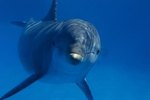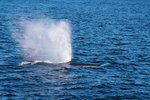
Despite being called killer whales, orcas (Orcinus orca) are actually dolphins. Historically, sailors took to calling these marine mammals whale killers after witnessing them preying on whales and other marine mammals. Over time the name changed. While these large animals are apex predators that threaten fish and other animals, as of 2013 there's never been a record of wild orcas attacking humans.
Taxonomy
Orcas are classified in the Delphinidae family of dolphins and porpoises. All delphinids belong to the Cetacean order within the toothed whale (Odontoceti) suborder. This means that all dolphins technically are whales; however, the term "whale" is usually reserved for baleen whales of the Mysticeti suborder. At least 32 species in the Delphinid family are split into dolphins and porpoises. While "dolphin" and "porpoise" historically were interchangeable terms, modern marine biologists consider only six species porpoises. All other delphinids, including orcas, are classified as dolphins.
Physical Features
Orcas have teeth, as both dolphins and porpoises do. Other physical characteristics align orcas with other dolphin species, including their streamlined bodies and rounded head that tapers into a distinct beak. In contrast, porpoises have chunkier bodies and squarer heads without beaks. Although orcas are the largest dolphin species, they are dwarfed by the largest baleen whales, including the blue whale, which is the largest animal in the world. The major physical feature that ensures orcas are dolphins is the presence of a melon. This fatty deposit assists the animals in echolocation and only exists in dolphins.
Echolocation
Dolphins, including orcas, are the only marine mammals that make extensive use of echolocation to hunt for prey and navigate their ocean home. Some marine biologists have hypothesized they also emit intense bursts of sound to stun their prey for easier capture. When they are swimming, orcas and other dolphins make low frequency sounds that reflect back to them, helping them understand the topography of the ocean floor and the shoreline, as well as alerting them to the presence of large animals or underwater obstacles. When exploring in more detail or hunting for prey, a series of clicks focused through their melons provides a more vivid three-dimensional picture.
Behavior
Orcas share many behavioral traits with other dolphins. As with many dolphin species, they live in pods and use cooperative hunting techniques. They are frequently found in shallower waters near the shore and don't dive as deeply as other cetaceans. Orcas not only prey on other dolphin species, they frequently eat animals that live partially or wholly on land, including seals, polar bears, penguins and even moose. Aided by their streamlined bodies, orcas swim swiftly in active pursuit of prey, as opposed to baleen whales that swim more slowly and eat by filtering tiny krill and plankton from the water.
References
Photo Credits
-
Tom Brakefield/Stockbyte/Getty Images
Writer Bio
Jennifer Mueller began writing and editing professionally in 1995, when she became sports editor of her university's newspaper while also writing a bi-monthly general interest column for an independent tourist publication. Mueller holds a Bachelor of Arts in political science from the University of North Carolina at Asheville and a Juris Doctor from Indiana University Maurer School of Law.




